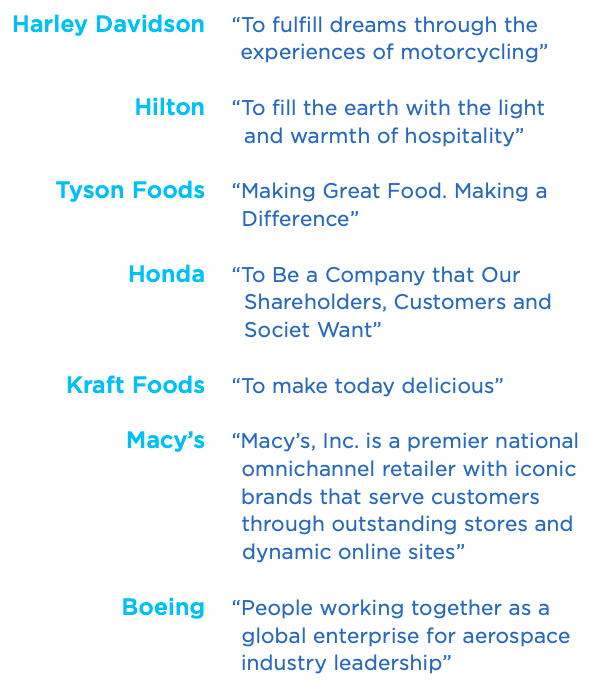The Sad State Of Vision Today
 Derek & Laura Cabrera
·
3 minute read
Derek & Laura Cabrera
·
3 minute read
This post is an excerpt from Chapter 2 of Flock Not Clock.
Many companies do in fact articulate a vision, though it often masquerades under different names like purpose or objective, and most frequently as mission.
As Collins and Porras wrote in 1991, “Most organizations respond to the need for vision by creating something they typically call a ‘mission statement.’" Mixing up vision and mission is basically an epidemic among leaders. This should not be dismissed as semantics. Vision, mission, capacity, and learning are all natural organizational functions. Vision is the future you see. Mission is the action you take to get there. They are quite different but vitally connected. Much more on that later. For now, let’s first provide some context about organizational visions.

Figure 2.2: This vision is... sad.
We’ve taken to snapping photos of visions and missions whenever we see them. This one, from a bank that will remain unnamed to protect the incompetent, made us laugh, but also cry. It was clear that the team that carefully crafted and lovingly printed this vision and mission on foam core didn’t have a good idea of the difference between vision and mission or even of what either was. Their vision —“To be the Trusted Resource”—is doubly unmeasurable as both “being” and “trustedness” are ongoing endeavors (a.k.a., moving targets). Worse than that, they’ve apparently achieved their vision already since their mission states they are the “trusted financial resource.” They’ve arrived! Time to close up shop! This kind of conflation, confusion, and lack of clarity in the flagship mental models of an organization (vision and mission) only amplifies problems downstream. It’s no simple thing to find a definition for vision, especially if you’re looking for something clear and succinct (say, a single sentence). Often authors will write an entire article about vision without providing a definition. Instead, they will write three paragraphs about what a vision is or is not and how it should function and what benefits it brings. Business Dictionary online does not define vision, but does provide one for vision statement: “An aspirational description of what an organization would like to achieve or accomplish in the mid-term or long-term future. It is intended to serves as a clear guide for choosing current and future courses of action.” The classic article on vision by Collins and Porras defines vision as consisting of “core ideology” (consisting of core purpose and core values) and “envisioned future” (consisting of big, hairy, audacious goal and vivid description). Still other authors use vision as an umbrella term to incorporate things like mission, values, and strategy.
 Perhaps the most troubling phenomenon with respect to organizational visions is the mismatch between the importance attributed to them and the fact that so many companies do not articulate one. Even given the tendency to confuse mission and vision (and most companies do have a mission statement), it is dismaying that many organizations do not articulate a desired goal or future state. How can you craft a strategy without an end in mind?
Perhaps the most troubling phenomenon with respect to organizational visions is the mismatch between the importance attributed to them and the fact that so many companies do not articulate one. Even given the tendency to confuse mission and vision (and most companies do have a mission statement), it is dismaying that many organizations do not articulate a desired goal or future state. How can you craft a strategy without an end in mind?
Fortune 500 companies, as an example, demonstrate substantial inconsistency and confusion about vision statements. One study found that fewer than 31% clearly identified a vision, and those that did demonstrated extreme inconsistency in their content and purpose. While authors and consultants use different definitions of vision, there is some consensus around the idea that a vision must be forward-looking and aspirational, yet sufficiently clear to be understood and provide direction.
There is, however, not much consensus on how far into the future a vision should stretch: Coca-Cola and Caterpillar both explain their “2020 vision,” while Volkswagen’s equivalent to a vision was crafted in 2014 and expires in 2018. Some consultants advise setting your vision for five or 10 years while others advise “medium-term targets,” and still others advise big, hairy, audacious goals (BHAG) which tend to be ambitious and long-term. This noteworthy discrepancy concerning projecting into the future aside, here’s a common understanding of vision: “Vision statements are future-based and are meant to inspire and give direction to the employees of the company, rather than to customers.”
The following companies’ vision statements illustrate the nature of our vision problem. Some are vague (and vapid), while others fail to depict a future state or goal. Others fall short in the inspiration department.
 Figure 2.3: A sample of vision statements.
Figure 2.3: A sample of vision statements.
On the whole, we’ve become accustomed to vision statements being throw-away lines devoid of meaning and any practical import whatsoever. The opportunity cost of such vague vision statements—or worse, not having one at all—is immense.
.png?width=150&height=150&name=CRL%20GOAT%20Logo%20(4).png)



